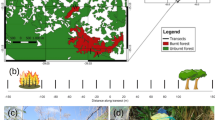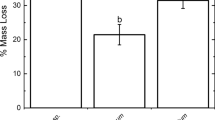Abstract
Phragmites australis (Common reed) occurs in the interface between water and land. The water depth gradient from deep water to dry land is inversely related to litter accumulation. Eutrophication can result in an excessive production of litter, which may have a large impact on the occurrence of P. australis in this gradient. In an outdoor pot experiment, it was investigated how water tables in combination with substrates containing variable amounts of litter affect morphology and productivity of P. australis. Vegetatively propagated P. australis was grown in pots filled with river sand, litter, and different mixtures of sand and litter (25, 50 and 75% by volume). Four water table treatments were applied; drained (–12 cm), waterlogged (0 cm), flooded (+12 cm), and weekly fluctuating drained and flooded conditions (–12/+12 cm of water relative to substrate level). When drained, no differences between substrate treatments were present. Waterlogging, flooding fluctuating water table treatments caused growth reduction in substrate containing litter. The plants formed short shoots and thin rhizomes. With increasing water table, allocation of dry matter to stems increased at the expense of leaves and rhizomes. At intermediate levels of litter in the substrate, allocation to leaves was lowest. In both instances a lower leaf weight ratio (LWR) was (partly) compensated for by a higher specific leaf area (SLA), resulting in less pronounced differences in leaf area ratio (LAR). Aquatic roots developed when plants were waterlogged or flooded, and increased when litter was present in the substrate. Aquatic roots were formed in the top soil layer when waterlogged. The percentage of aquatic roots increased with increasing amount of litter in the substrate when plants were flooded. It was concluded that the morphological responses of P. australis to litter strongly constrain its ability to maintain itself in deep water when the substrate contains litter. This might one of the explanations for the disappearance of P. australis along the waterward side of littoral zones.
Similar content being viewed by others
References
Armstrong, J., Armstrong, W. and Van der Putten, W.H. 1996. Phragmites die-back: bud and root death, blockages within the aeration and vascular systems and the possible role of phytotoxins. New Phytol. 133: 399–414.
Boar, R.R., Crook, C.E. and Moss, B. 1989. Regression of Phragmites australis reedswamps and recent changes in water chemistry in the Norfolk Broadland, England. Aquat. Bot. 35: 1–4.
Black, C.A. 1965. Methods of soil analysis. American Society of Agronomy, Inc. Madison, Wisconsin, U.S.A.
Buttery, B.R., Williams, W.T. and Lambert, J.M. 1965. Competition between Glyceria maxima and Phragmites communis in the region of Surlingham Broad. Ill. The fen gradient. J. Ecol. 53: 183–194.
Causton, D.R. and Venus, J.C. 1981. The Biometry of Plant Growth. Arnold, London.
Čižková, H., Strand, J.A. and Lukavská, J. 1996a. Factors associated with reed decline in an eutrophic fishpond, Rožmberk (South Bohemia, Czech Republic). Folia Geobot. Phytotax. 31: 73–84.
Čižková, H., Lukavská, J., Pribán, K., Kopecký, J and Brabcová, H. 1996b. Carbohydrate levels in rhizomes of Phragmites australis at an oligotrophic and an eutrophic site: A preliminary study. Folia Geobot. Phytotax. 31: 111–118.
Clevering, O.A. 1995. Life-history characteristics of Scirpus lacustris and Scirpus maritimus with special reference to the restoration of these species in former tidal areas. Ph.D. thesis. University of Nijmegen, The Netherlands.
Clevering, O.A. and Van der Putten, W.H. 1995. Effects of detritus accumulation on the growth of Scirpus maritimus under greenhouse conditions. Can. J. Bot. 73: 852–861.
Crawford, R.M.M. 1996. Whole plant adaptations to fluctuating water tables. Folia Geobot. Phytotax. 31: 7–24.
Den Hartog, C., Květ, J. and Sukopp H. 1989. Reed. A common species in decline. Aquat. Bot. 35: 1–4.
Givnish, T.J. 1979. On the adaptive significance of leaf form. In: Solbrig, O.T., Jain, S., Johnson, G.B. and Raven, P.H. (eds), Topics in Plant Population Biology. pp. 375–407. Columbia University Press, New York.
Givnish, T.J. 1986. Optimal stomatal conductance, allocation of energy between leaves and roots, and the marginal cost of transpiration. In: Givnish, T.J. (ed.), On the Economy of Plant Form and Function. pp. 171–214. Cambridge University Press, New York.
Hara, T., Van der Toorn, J. and Mook, J. H. 1993. Growth dynamics and size structure of shoots of Phragmites australis, a clonal plant. J. Ecol. 81: 47–60.
Haslam, S.M. 1972. Biological flora of the British Isles no. 128: Phragmites communis Trin. J. Ecol. 60: 585–610.
Hudec, K. and Stastny, K. 1978. Birds in the reedswamp ecosystem. In: Dykyjova, D. and Kvet, J. (eds), Pond Littoral Ecosystems. pp. 366–375. Springer-Verlag, Berlin.
Hutchinson, G.E. 1975. A Treatise on Limnology, Vol. III. Limnological Botany, John Wiley, New York.
Jordan, T.E., Whigham, D.F., and Corell, D.L. 1990. Effects of nutrient and litter manipulations on the Narrow-Leaved Cattail, Typha angustifolia L. Aquat. Bot. 36: 179–191.
Jupp, B.P. and Spence, D.H.N. 1977. Limitations of macrophytes in a eutrophic lake, loch Leven. II. Wave action, sediments and waterfowl grazing. J. Ecol. 65: 431–446.
Končalová, H. 1990. Anatomical adaptations to waterlogging in roots of wetland graminoids: limitations and drawbacks. Aquat. Bot. 38: 127–134.
Kubin, P., Melzer, A. and ižková, H. 1994. The relationship between starch content in rhizomes of Phragmites australis (Cav) Trin ex Steud and trophic conditions of habitat. Proceedings of the Royal Society of Edinburgh Section B – Biological Sciences 102: 433–438.
Odum, E.P. 1971. Fundamentals of ecology. 2nd edn. Saunders, Philadelphia, U.S.A.
Odum, W.E. 1990. Internal processes influencing the maintenance of ecotones: do they exist?. In: Naiman, R.J. and Decamps, H. (eds), The Ecology and Management of AquaticTerrestrial Ecotones. Man and the Biosphere Series 4: 91–102.
Ostendorp, W. 1989. &Die-Back'of reeds in Europe – A critical review of literature. Aquat. Bot. 35: 5–26.
Patrick Jr., W.J. and Mikkelsen, D. 1971. Plant nutrient behaviour in flooded soil. In: Olson, R.A., Army, T.J., Honway, J.J. and Kilmer, V.J. (eds), Fertilizer Technology and Use. pp. 187–216. Soil Sc. Soc. Am., Mc. Madison, Wisconsin, U.S.A.
Ponnamperuma, F.N. 1972. The chemistry of submerged soils. Adv. Agron. 24: 29–95.
Rea, N. 1996. Water levels and Phragmites: Decline from lack of regeneration or dieback from shoots death. Folia Geobot. Phytotax. 31: 85–90.
Van der Putten, W.H., Peters, B.A.M. and Van der Berg, M.S. 1997. Effects of litter on substrate conditions and growth of emergent macrophytes. New Phyt. 135: 527–537.
Votrubová, O. and Pecháčková, A. 1996. Effect of nitrogen over-supply on root structure of common reed. Folia Geobot. Phytotax. 31: 119–125.
Waters, I. and Shay, J.M. 1991. A field study of the effects of water depth, order of emergence and flowering on the growth of Typha glauca shoots using the Richards model. Aquat. Bot. 39: 231–242.
Weisner, S.E.B. 1987. The relation between wave exposure and distribution of emergent vegetation in a eutrophic lake. Freshw. Biol. 18: 537–544.
Weisner, S.E.B. 1988. Factors affecting the internal oxygen supply of Phragmites australis (Cav.) Trin. ex Steudel in situ. Aquat. Bot. 31: 329–335.
Weisner, S.E.B. 1991. Within-lake patterns in depth penetration of emergent vegetation. Freshw. Biol. 26: 133–142.
Weisner, S.E.B. and Graneli. W. 1989. Influence of substrate conditions on the growth of Phragmites australis after a reduction in oxygen transport to below-ground parts. Aquat. Bot. 35: 71–80.
Yamasaki, S. 1984. Role of plant aeration in zonation of Zizania latifolia and Phragmites australis. Aquat. Bot. 18: 287–297.
Yamasaki, S. 1987. Oxygen demand and supply in Zizania latifolia and Phragmites australis. Aquat. Bot. 29: 205–215.
Author information
Authors and Affiliations
Rights and permissions
About this article
Cite this article
Clevering, O. Effects of litter accumulation and water table on morphology and productivity of Phragmites australis. Wetlands Ecology and Management 5, 275–287 (1997). https://doi.org/10.1023/A:1008233912279
Issue Date:
DOI: https://doi.org/10.1023/A:1008233912279




